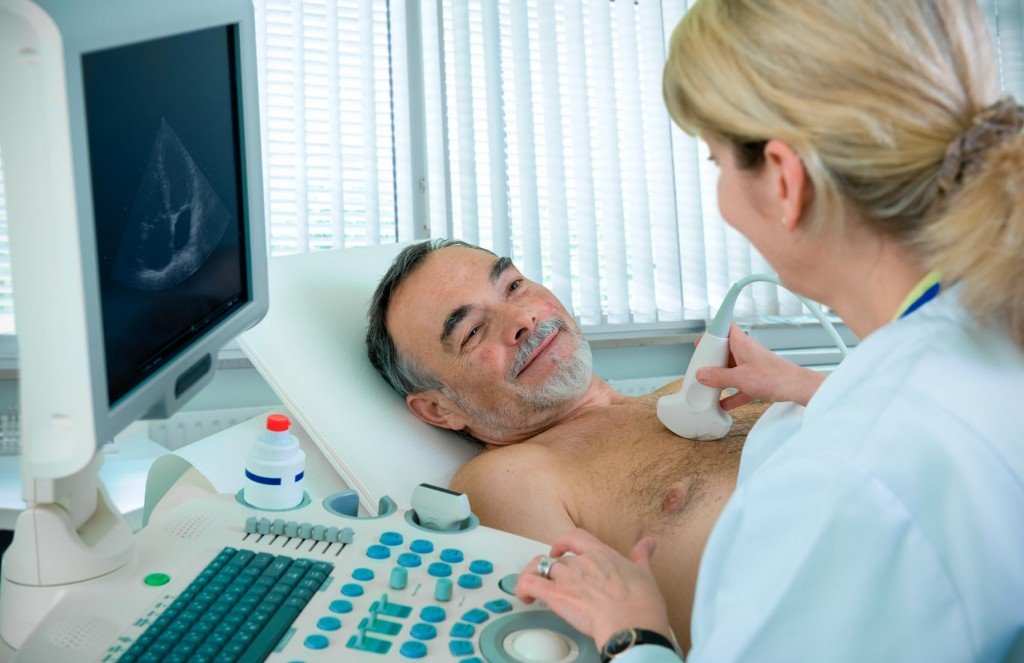Pushpa Larsen, ND
Last year, 64% of women and 50% of men who died suddenly of a heart attack had no prior knowledge of their heart disease. Forty to fifty percent of all heart attack patients have a “normal” cholesterol profile. As NDs, we recognize that cholesterol – even abnormally high cholesterol – is not necessarily the primary villain when we are assessing our patients’ risk for cardiovascular events. Although we pay attention to other laboratory markers, such as CRP, homocysteine and others, and we also give importance to lifestyle factors and family history, it is sometimes difficult to know how to weigh any particular combination of risk factors.
When clinical symptoms are present, such as chest pain or abnormal heart sounds, it is common to order a stress EKG. However, this only detects a problem when one of the major arteries is 70% or more occluded. Yet, 86% of heart attacks occur at less than 70% occlusion. Obviously, this isn’t adequate if you are trying to be proactive in treating early heart disease. Angiography is the current gold standard for assessing arterial disease, but it is expensive and invasive. It isn’t useful for checking to see who might be developing heart disease, especially those who have no clinical signs or symptoms.
Recently, a relatively inexpensive, non-invasive test has become available for use in office-based practices that can revolutionize the way we assess risk as well as monitor the efficacy of our treatments. This test is Carotid Intima-Media Thickness (CIMT) Scanning, often referred to as an IMT scan.
What Does an IMT Scan Measure?
IMT scanning is an ultrasound scan of the carotid artery walls, using B-mode ultrasound and sophisticated, FDA-cleared software. Used as a clinical end-point in thousands of research studies over the past 16-plus years, IMT scanning has been thoroughly validated and is well accepted in the conventional research community. This technology should not be confused with duplex ultrasound (US) of the carotid arteries offered to the general public by health screening companies. Duplex US generally detects narrowing of the arterial lumen and velocity of blood flow.
IMT scanning measures the thickness of the two innermost layers of the arterial wall, the tunica intima and tunica media, and also visualizes the presence of plaque in the walls of the arteries as well as in the lumen. IMT scans further characterize plaque as soft, calcified or heterogeneous. Soft plaque is the most dangerous, as it is unstable and most likely to rupture, leading to a thrombus. Calcified plaque is older, and occurs when the body lays down a hard “shell” of calcium. It is least likely to rupture, although it can continue to grow and eventually occlude the artery. It is this calcified plaque that causes “hardening” of the arteries, with the accompanying loss of arterial resilience. Heterogeneous plaque is a soft plaque on its way to being calcified. It is still prone to rupture, but more stable than fully soft plaque. According to Dr. Bradley Bale of the Heart Attack Prevention Clinic in Spokane, Wash., “The plaque data gathered in the IMT test is a huge bonus … Plaque is 10 times more predictive of heart attack and strokes [than information on narrowing of the arteries]; the results are even more dramatic in females. In other words, finding plaque is more important than determining how narrow the arteries have become” (online posting, 2005).
It is worth noting that IMT scans detect the actual presence (or absence) of disease and are able to directly assess the progression of disease.
Small Procedure, Big Answers
IMT scanning takes about 10 minutes. Patients do not need to undress and are not exposed to any radiation. The sonographer takes three views of each wall of both left and right common carotid arteries. The resulting 12 ultrasound views are analyzed by software that measures a 1cm segment of each of the views pixel by pixel. This results in more than 400 measurements that are averaged to arrive at a mean IMT. This mean IMT measurement is correlated with very clear thresholds for increasing risk of stroke and heart attack, including shorter-term risk when the mean IMT measurement exceeds 1.0mm.
The number of measurements taken makes this technique highly reproducible. Measurements greater than 1.3mm are excluded from the mean, as 1.3mm is the point at which the thickened intima-media is characterized as plaque. Therefore, the mean IMT is a measure of arterial wall thickness exclusive of plaque, which is reported separately. This precludes large plaques from skewing the IMT mean and increases utility of the measurement. Maximum regions exclusive of plaque are also separately reported. Mean IMT is then graphed by age and gender to arrive at an arterial “age.” There is reliable IMT data by gender for ages five to 80. While the IMT mean and max numbers provide more specific information for the clinician, the arterial age is the number that patients most easily relate to.
Results are typically available one week to 10 days after testing. In my practice, I provide patients a copy of their IMT scan report in a follow-up visit, along with a written interpretation of those results, treatment recommendations and suggestions for further testing if indicated.
IMT Scans in Clinical Practice
The old adage that “a picture is worth a thousand words” holds true here. Having an actual picture of their arteries – regardless of whether or not they understand what they are looking at – has a galvanizing effect on some patients. Suddenly, the specter of cardiovascular disease moves out of the realm of the theoretical and into here-and-now-in-my-body reality. I have seen patients make dramatic positive changes in their lives as a result of having an IMT scan. One 35-year-old man stopped chewing tobacco, increased his exercise and made changes in his diet after finding out that he had the arteries of a 63-year-old. This rippled out to his family, improving the eating habits of his wife and two young sons.
This young man initially came in for an IMT scan only to appease his wife, who was concerned about a history of heart disease in his family. He was tall and relatively lean, working at a physically demanding job. His blood pressure was 118/78. After his IMT scan, we drew a fasting standard lipid panel, chem screen and other markers, as he had not had a physical exam or lab work in his adult life. His results certainly did not suggest that he was at risk for heart disease: total cholesterol was 199, with an LDL of 101 and HDL of 82. His high sensitivity CRP was in the 1st quintile. The only obvious value of concern was a fasting glucose of 102. At the time of his IMT scan, he denied current tobacco use, which was uncovered with later questioning because of his dramatic IMT results. He had stopped smoking five years prior at the birth of his oldest son, and didn’t think that chewing tobacco “counted.”
Repeat scans for patients at risk can be used to assess the efficacy of treatment and progression of disease. How quickly the intima-media is thickening has been found to be a significant indicator of future cardiac events.
A Tool that Belongs in Family Practice
Relatively few family practice physicians (MD or ND) use IMT scanning in their practices. Most IMT scans are performed in cardiology clinics. However, people don’t generally see cardiologists until they have had a heart attack or stroke, or are starting to have symptoms, such as chest pain. While IMT scanning may be useful in cardiology clinics to monitor response to treatment, the more appropriate and useful place for it is in a primary care setting. Very early detection of cardiovascular disease allows us to use our naturopathic therapeutics long before surgical or pharmaceutical interventions are deemed necessary … in other words, to perform true prevention.
The American Heart Association has endorsed CIMT scanning as an independent cardiac risk diagnostic tool in people older than age 45. People younger than 45 should be tested if they have risk factors (Greenland et al., 2000). Dr. Bale, however, would dispute this age recommendation. He states, “Some of the most impressive results at our clinic have been in teenagers, who appear to be in excellent health but, in reality, have arteries diseased to the age of adults in their 30s or 40s” (online posting, 2005).
Research Validation of IMT Measurement
A plethora of data correlates IM thickness with various risk factors, ages and cardiovascular events. Here are a few of the most notable findings:
- Increased carotid intima-media thickness has been positively correlated with systolic blood pressure, pack-years of smoking, elevated blood glucose and duration of diabetes (Van der Meer et al., 2004; Chambless, 1997).
- There is an inverse correlation between IMT and HDL levels and IMT and socio-economic status (Ranjit et al., 2006; Lynch et al., 1997).
- In one large study, IMT scanning was found to be a better predictor of cardiovascular events than angiogram (Hodis et al., 1998).
- The same study found that progression of IM thickness was significantly related to the risk of a future cardiovascular event. For each 0.03mm/year thickening of the intima-media, there was a relative risk of 2.2 for fatal MIs and 3.1 for non-fatal MIs.
- A study published in August 2006 linked increased IM thickness in pregnant women with pre-eclampsia (Blaauw et al., 2006). It is unknown whether the pre-eclampsia preceded the thickened intima-media or vice versa, but there is evidence that pre-eclampsia in pregnancy is linked to development of cardiovascular disease later in life.
Economics of IMT Scanning
Purchasing the hardware and software to provide IMT scanning in-house – in the tens of thousands of dollars – would be prohibitive for most NDs, not to mention the cost of having a sonographer trained in the technique. Fortunately, it is possible to provide this test without any investment by using a reputable company that provides the service. After scheduling a scanning date with my service provider, I schedule patients for scans in 10-minute increments throughout the day. To be cost effective, 16-24 patients should be scheduled for a half-day of scanning, or 36-48 patients for a full day. Assistants work with me to take vital signs, height and weight, and to complete risk questionnaires. I listen to each patient’s heart. I bill the insurance company for a brief office visit and I also bill for the IMT scan. I pay the service provider a fee per patient for providing the scan and report, which is less than the fee I am reimbursed by insurance or paid by patients. The balance of the fee covers the “rent” of one of my exam rooms for the sonographer to work in, and for my time in reviewing and writing reports for patients.
Most health insurance companies are covering the cost of IMT scanning for patients who have certain identifiable risk factors, although my experience thus far is that some companies will not reimburse NDs. Typically, insurance companies want to see a diagnosis of high cholesterol, low HDL cholesterol or high blood pressure to pay for the test. They may not accept a family history of heart disease, stroke or diabetes as justification for IMT scanning, which is unfortunate. The cost of IMT scanning for those paying out of pocket in the Seattle area varies from $195 in a family practice clinic to $356 in some cardiology clinics.
Using IMT Scanning in Naturopathic Research
One of the most important uses I see for IMT scanning, beyond the benefit to individual patients, is the opportunity to use a well-established research tool to evaluate naturopathic protocols. Because it is possible to see actual reversal of cardiovascular disease using IMT scanning, it is ideal to demonstrate the efficacy of our therapeutics – or to discover that some dearly held therapeutics may not be as effective as we might believe. Already, conventional research is using IMT to evaluate therapies such as antioxidants in reversing the progression of atherosclerosis (Azen et al., 1996; Rissanen et al., 2003).
I understand that at least one family practice physician who has been using IMT regularly for several years typically sees decreases in arterial age averaging seven years, along with decreases in soft plaque. This physician treats fairly aggressively, using conventional pharmaceuticals along with a strong emphasis on diet and exercise. It will be interesting to see if we can achieve similar results solely using naturopathic medicine. Documentation of such results with IMT scans holds enormous possibilities for our profession.
What to Look for in a Service Provider
An essential component of the reproducibility of IMT measurements is the level of training and evaluation of the sonographer and the technician reading the scan. IMT training is not currently included in most ultrasound school curriculums. Although registered vascular technicians and other sonographers may be familiar with the anatomy of the common carotid artery, in the absence of specific training for IMT, they will be unfamiliar with the angles optimal for reading, and the pictures they take may not correlate to known literature (Eldridge, personal communication, 2005-2006). For IMT measurements, the correct angle is essential to an accurate and reproducible scan. Sonographers should be regularly tested for consistency between operators as well as consistency of each operator with repeated scans on individual patients. Evaluation should be blinded and rigorous. Retraining should be done on a regular basis to prevent “drift” into non-optimal scanning angles.
Another important criterium is for the service provider to have an established and well-defined protocol that incorporates or includes protocols from major studies. There are more than 3,000 IMT peer-reviewed articles and studies. Although many used similar protocols, there are quite a few differences between them. For the results reported by the service bureau to be meaningful in evaluating a patient’s results against published data, the scanning protocol must be consistent with and inclusive of the protocols used in the most commonly quoted studies. This protocol must then be reinforced in the training and evaluation of sonographers. Each sonographer and reader should be held to specific performance and certification thresholds.
IMT scan readers also should have regular training and evaluation. The importance of this can be understood in light of the fact that a progression of as little as 0.03mm per year in the thickness of the intima-media has been correlated with a very high risk of future ischemic events. This is about half the size of a single pixel on the average computer screen, so an error of a single pixel can lead one to a false perception of disease progression or lack thereof, and perhaps change treatment recommendations. IMT scans should be read on high-resolution monitors under controlled lighting conditions so that reading is consistent and reproducible (Eldridge, personal communication, 2005-2006).
References
Article on KXLY, Spokane, 4 Your Health web site, 2005. No longer available online.
Greenland P et al: AHA prevention conference V conference proceedings: Beyond secondary prevention: Identifying the high-risk patient for primary prevention: Noninvasive tests of atherosclerotic burden, Circulation 101:e16-e22, 2000.
Van der Meer IM et al: Predictive value of noninvasive measures of atherosclerosis for incident myocardial infarction: The Rotterdam study, Circulation 109:1089-1094, 2004.
Chambless LE et al: Association of Coronary Heart Disease incidence with carotid arterial wall thickness and major risk factors: The atherosclerosis risk in communities (ARIC) study, 1987-1993, American Journal of Epidemiology 146(6):483-494, 1997.
Ranjit N et al: Socioeconomic differences in progression of carotid intima-media thickenss, in the atherosclerosis risk in communities study, Arteriosclerosis, Thrombosis, and Vascular Biology 26:411-416, 2006.
Lynch J et al: Socioeconomic status and progression of carotid atherosclerosis: Prospective evidence from the kuopio ishcemic heart disease risk factor study, Arteriosclerosis, Thrombosis, and Vascular Biology 17:513-519, 1997.
Hodis HN et al: The role of carotid arterial intima-media thickness in predicting clinical coronary events, Annals of Internal Medicine Feb 15;128(4): 262-9, 1998.
Blaauw J et al: Increased intima-media thickness after early-onset preeclampsia, Obstetrics & Gynecology June;106(6):133345-51, 2006.
Wikstrom AK et al: The risk of maternal ischaemic heart disease after gestational hypertensive disease, British Journal of Obstetrics & Gynecology Nov: 112(11):1486-91, 2005.
Todd Eldridge of CardioRisk UltraSound: Personal communications, July 2005-October 2006.
Azen SP et al: Effect of supplementary antioxident vitamin intake on carotid arterial wall intima-media thickness in a controlled clinical trial of cholesterol lowering, Circulation 94: 2369-2372, 1996.
Salonen RM et al: Six-year effect of combined vitamin C and E supplementation on atherosclerotic progression: The Antioxident Supplementation in Atherosclerosis Prevention (ASAP) study, Circulation 107:947-953, 2003.
Rissanen T et al: Serum lycopene concentrations and carotid atherosclerosis: the kuopio ischaemic heart disease risk factor study, American Journal of Clinical Nutrition 77:133-8, 2003.
 Pushpa Larsen, ND graduated from Bastyr University with specialty certificates in Naturopathic Midwifery and Spirituality Health and Medicine. She is a past vice president of the Washington Association of Naturopathic Physicians, and has been a research clinician for the Bastyr University Research Institute. Larsen has been a preceptor for midwifery students at Bastyr and is currently an affiliate clinical faculty for the naturopathic medicine program, training students in her clinic. She writes a health column for Pure E magazine and presented on early detection of cardiovascular disease at the 2006 AANP convention. Her family practice in Seattle serves patients from newborn to age 85. In addition to her use of traditional naturopathic therapeutics, Larsen incorporates guided imagery and sound therapy in her work with patients.
Pushpa Larsen, ND graduated from Bastyr University with specialty certificates in Naturopathic Midwifery and Spirituality Health and Medicine. She is a past vice president of the Washington Association of Naturopathic Physicians, and has been a research clinician for the Bastyr University Research Institute. Larsen has been a preceptor for midwifery students at Bastyr and is currently an affiliate clinical faculty for the naturopathic medicine program, training students in her clinic. She writes a health column for Pure E magazine and presented on early detection of cardiovascular disease at the 2006 AANP convention. Her family practice in Seattle serves patients from newborn to age 85. In addition to her use of traditional naturopathic therapeutics, Larsen incorporates guided imagery and sound therapy in her work with patients.





